Once Upon A Time in the Steppes - Part Four
Read Part One // Read Part Two // Read Part Three
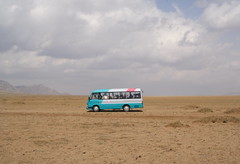 After finishing our lunch at the horse camp and throwing our bags into the bus we hit the road... or more accurately hit the dirt that was currently serving as road. We were heading the ruined monastery of Ovgon Khiid, where one of Mongolian Buddhism's founding figures, Zanabazar, once fled from rival armies. The guy chose a pretty good hiding spot, as we had to cross several horizons' worth of empty desert before coming across the rocky masses that sheltered the remnants of the shrine. The main temple ruins were apparently further back along a rocky, scrub-lined valley, but we contented ourselves with peeking inside a few of the contemporary shrines that a local family had been restoring since 1994. We were looking to get to Karakorum, site of Chinggis Khaan's old capital city, before evening, so we left the desert behind and eventually found our way to a road heading back eastwards.
After finishing our lunch at the horse camp and throwing our bags into the bus we hit the road... or more accurately hit the dirt that was currently serving as road. We were heading the ruined monastery of Ovgon Khiid, where one of Mongolian Buddhism's founding figures, Zanabazar, once fled from rival armies. The guy chose a pretty good hiding spot, as we had to cross several horizons' worth of empty desert before coming across the rocky masses that sheltered the remnants of the shrine. The main temple ruins were apparently further back along a rocky, scrub-lined valley, but we contented ourselves with peeking inside a few of the contemporary shrines that a local family had been restoring since 1994. We were looking to get to Karakorum, site of Chinggis Khaan's old capital city, before evening, so we left the desert behind and eventually found our way to a road heading back eastwards.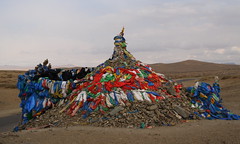 We stopped twice along the way; the first time was at a massive ovoo next to the road. One of my favorite sights during our travels, ovoo are cairns of small rocks and blue silk banners which dot the Mongolian roadsides, mountaintops, and other spiritually important locales. We saw dozens during the course of our trip. Custom is to circle the ovoo three times (or, if driving past, honk in recognition), adding a lose rock from the ground to the pile if one is free; we took the opportunity to throw the blessed rice we had received from the shaman back in Darkhan while wishing for good fortune and safe travels.
We stopped twice along the way; the first time was at a massive ovoo next to the road. One of my favorite sights during our travels, ovoo are cairns of small rocks and blue silk banners which dot the Mongolian roadsides, mountaintops, and other spiritually important locales. We saw dozens during the course of our trip. Custom is to circle the ovoo three times (or, if driving past, honk in recognition), adding a lose rock from the ground to the pile if one is free; we took the opportunity to throw the blessed rice we had received from the shaman back in Darkhan while wishing for good fortune and safe travels.Our next stop was for a mother and daughter from Holland who had apparently forgotten to circle their ovoos, and whose touring van had caught a flat out in the middle of nowhere. We invited them into the bus along with their translator, driver, and the affronting tire. We chatted for a while before arriving at around six in the evening and dropping them off in Karakorum, their destination and ours. Modern Karakorum is a small town with a Soviet-era flour factory and not much else; there is, however, the large Erdene Zuu Buddhist monastery, Mongolia's first. When we arrived it was closing, however, and the wind had kicked up strong, sending us and the small herd of baby goats hanging around outside the walls running for cover. We planned to come back the next morning, and retired to a ger camp and short drive away on the edge of town, sheltered by some nearby mountains and with a river running nearby.
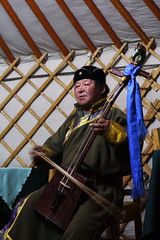 The gers, as usual, were cozy, and that night after dinner the camp offered entertainment in the form of a small concert inside the dining tent; one old man playing the morin khuur (horse fiddle), one performing khuumi (throat singing) and one young girl in a purple leotard performing a cringe-inducing contortion act. After the concert, we were offered a chance to try the instruments ourselves firsthand, which was cool. (They did not suggest we try the contortions.) We finished the evening with some card games in our gers; outside it had gotten even colder, and the crackling wood stove was a welcome tent-mate.
The gers, as usual, were cozy, and that night after dinner the camp offered entertainment in the form of a small concert inside the dining tent; one old man playing the morin khuur (horse fiddle), one performing khuumi (throat singing) and one young girl in a purple leotard performing a cringe-inducing contortion act. After the concert, we were offered a chance to try the instruments ourselves firsthand, which was cool. (They did not suggest we try the contortions.) We finished the evening with some card games in our gers; outside it had gotten even colder, and the crackling wood stove was a welcome tent-mate.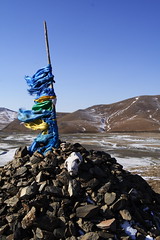 The next morning we woke up to .. snow! As I mentioned before, we had been told to expect all variety of weather during the Mongolian spring, but as cold as it got during our R&R I didn't really expect to be enjoying snowclad hillsides in the middle of May. The snow meant we could forget about hot water in the ger camp, so showers were out that morning; it was pretty enough that nobody complained, though. After a quick breakfast we hiked up one of the low mountains next to the camp, to see a monument at the top commemorating three great kingdoms in Mongolian history: those of (if my notes are right) the Hunus, the Turks, and Chinggis Khaan's own Mongolian empire. I need to learn more Central Asian history; if anyone out there reading this happens to have recommendations for a good introductory primer on the region, feel free to drop a note in the comments.
The next morning we woke up to .. snow! As I mentioned before, we had been told to expect all variety of weather during the Mongolian spring, but as cold as it got during our R&R I didn't really expect to be enjoying snowclad hillsides in the middle of May. The snow meant we could forget about hot water in the ger camp, so showers were out that morning; it was pretty enough that nobody complained, though. After a quick breakfast we hiked up one of the low mountains next to the camp, to see a monument at the top commemorating three great kingdoms in Mongolian history: those of (if my notes are right) the Hunus, the Turks, and Chinggis Khaan's own Mongolian empire. I need to learn more Central Asian history; if anyone out there reading this happens to have recommendations for a good introductory primer on the region, feel free to drop a note in the comments. 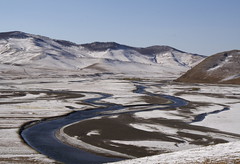
 After winding our way down the hillside past more snow-covered ovoo, we left our ger camp and went to see Erdene Zuu. The monastery's walls (capped with a hundred eight stupa crenelations) were built from the remnants of Chinggis' capital, of which nothing now remains save for two turtle-shaped cornerstones that once marked the outer boundaries of the city. I have to admit that Erdene Zuu, while housing some beautiful art and architecture, didn't really capture my attention in the way some of our other travels in Mongolia did. Though I'm not given to religious sentiments in general, I personally find the worldly withdrawal of Buddhist ritual monasticism an unsatisfying response to the "life of suffering" they see around them. As visually interesting as the confusing array of religious symbolism present in their art may be, I can't help but wonder how much reassurance lay-practitioners really derive from the thought that the monks whom they supported through tithing and donations have now passed on to enlightenment while they remain behind. It's not really for me to judge, I guess, but it all felt very ornate in an otherwise very barren land. Anyhow, we left the monastery and stopped on our way out of town to see the second surviving turtle rock — which was up on the mountainside quite a ways from the first, suggesting Karakorum's large size in its day. We ate a lunch of sausage and cucumber sandwiches in the van as we bounced along listening to a tape of Mongolian pop balads, travelling back in the direction of Ulaan Bator.
After winding our way down the hillside past more snow-covered ovoo, we left our ger camp and went to see Erdene Zuu. The monastery's walls (capped with a hundred eight stupa crenelations) were built from the remnants of Chinggis' capital, of which nothing now remains save for two turtle-shaped cornerstones that once marked the outer boundaries of the city. I have to admit that Erdene Zuu, while housing some beautiful art and architecture, didn't really capture my attention in the way some of our other travels in Mongolia did. Though I'm not given to religious sentiments in general, I personally find the worldly withdrawal of Buddhist ritual monasticism an unsatisfying response to the "life of suffering" they see around them. As visually interesting as the confusing array of religious symbolism present in their art may be, I can't help but wonder how much reassurance lay-practitioners really derive from the thought that the monks whom they supported through tithing and donations have now passed on to enlightenment while they remain behind. It's not really for me to judge, I guess, but it all felt very ornate in an otherwise very barren land. Anyhow, we left the monastery and stopped on our way out of town to see the second surviving turtle rock — which was up on the mountainside quite a ways from the first, suggesting Karakorum's large size in its day. We ate a lunch of sausage and cucumber sandwiches in the van as we bounced along listening to a tape of Mongolian pop balads, travelling back in the direction of Ulaan Bator. 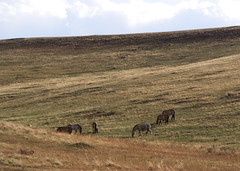 We weren't done with our travels yet, though, as we had one more stop planned: Khustain National Park, home of the Mongolian takhi, also known as Przewalski's wild horse. We arrived after several hours of driving and settled into the ger camp there, figuring we would go out to see the horses after dinner; we got word, however, that the wind was picking up and a nearby herd was likely going to start moving, so the best time to go seem them would be now. The takhi are true wild horses, genetically distinct from domesticated breeds or feral horses (domesticated horses that have escaped human captivity and gone wild). Short, stocky, and sandy-colored, they had vanished from their natural habitats until reintroduction programs begun in the 1990s started reintroducing them to Mongolian national parks like Khustai. The herd or around a dozen we saw, grazing at a distance of several hundred yards away (too far for my lens zoom to get a good capture, I'm afraid), had several pregnant females amongst it, and Khustai alone now has over 150 of the animals living in its area.
We weren't done with our travels yet, though, as we had one more stop planned: Khustain National Park, home of the Mongolian takhi, also known as Przewalski's wild horse. We arrived after several hours of driving and settled into the ger camp there, figuring we would go out to see the horses after dinner; we got word, however, that the wind was picking up and a nearby herd was likely going to start moving, so the best time to go seem them would be now. The takhi are true wild horses, genetically distinct from domesticated breeds or feral horses (domesticated horses that have escaped human captivity and gone wild). Short, stocky, and sandy-colored, they had vanished from their natural habitats until reintroduction programs begun in the 1990s started reintroducing them to Mongolian national parks like Khustai. The herd or around a dozen we saw, grazing at a distance of several hundred yards away (too far for my lens zoom to get a good capture, I'm afraid), had several pregnant females amongst it, and Khustai alone now has over 150 of the animals living in its area.We saw some horses of the domesticated kind up close after dinner that evening, as two local cowboys were offering the chance to go on a dusk ride for something like two dollars per person. Though not as free ranging as our first experience — we went out in small groups of four and spent the entire ride tethered close to our two guides, so no unscheduled departures for me this time — it was still nice to ride out under clear night skies.
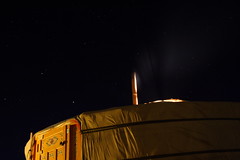
The next morning we had an early breakfast and made the drive back to Ulaan Bator, where our R&R officially concluded. We planned to return to the care of the national HFH offices for a few farewell ceremonies before our late evening flight out, but Batbold the national coordinator was busy in meetings for the moment so we stayed with our tour guides a little longer. We checked into the same hotel we stayed at our first night and got two rooms to store our bags in, then left with the tour bus to downtown UB in search of an internet cafe. There we filled our some surveys for HFH Mongolia and said some tearful goodbyes to our guide and translator, Ogi... until she came back some twenty minutes later, off work, and offered to show us around one last time at the national Natural History Museum that some of us had hoped to catch sight of while we were there. It was a bit of a whirlwind tour, as we had to meet Batbold for lunch soon afterwards, but we managed to see most everything on display — lots of unlucky stuffed animals, both native to Mongolia and otherwise, and one large exhibit of dinosaur bones, Mongolia's claim to international paleontological fame. No cast replicas either, these were the actual bones dug out of the Gobi rock — including, under protective glass case, the famous fossil of the protoceratops locked in combat with a small raptor. Pretty cool stuff, although unfortunately we took no pictures. After that we did say goodbye to Ogi, and went by cab to meet Batbold for a quick lunch.
Then it was shopping time — an hour and a half in the Ulaan Bator State Department Store. I'm guessing shelves have improved considerably since Soviet times, as almost all floors were filled with shoppers stocking up, as we were, on souvenirs, food, and gifts. Mongolia HFH evidently didn't have their own t-shirts, so I had to buy a general Mongolian flag one for myself, as well as a patch for the old hiking bag; I also brought back after much deliberation a horse fiddle for Ms. Riddarfjarden, who is a cello player and quite fond of their sound. Though still half-full from our late lunch, it was then time to head on to our thank-you dinner at ... yes, Mongolian barbecue! Although technically, speaking, it's neither, it was still pretty delicious. We also received thank-you certificates and met with one of the Mongolia HFH national affiliate's board members and his young son, who really didn't want to be there with us, even when bribed with ice cream. The rest of the HFH folks were very appreciative, though, and it was a nice meal, albeit a little rushed at the end as we had one more sight to see.
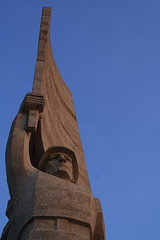 The national Tumen Ekh ensemble performs traditional Mongolian dance, songs, throat singing, moriin khuur, and more contortionists. It was a great performance.. so suffice it so say I was extremely frustrated when my camera battery died off five minutes into the performance. You'll just have to trust me when I say it was impressive, I suppose. After that we took a drive up to Zaisan Memorial, which I was able to briefly capture thanks to five minutes of quick battery-charging in the bathroom after the concert. A large hill overlooking the whole of Ulaan Bator below, Zaisan on that evening was swarming with recently graduated high school students, wedding parties, and other folks out enjoying the panoramic views; we made quite a few friends with the younger kids, whose English put our shogakkusei here in Japan to shame. The monument, dedicated to Russian-Mongolian friendship, had some pretty classic Soviet-era murals too. Eventually we made our way back down and regretfully headed back to the hotel to pack up and leave UB behind.
The national Tumen Ekh ensemble performs traditional Mongolian dance, songs, throat singing, moriin khuur, and more contortionists. It was a great performance.. so suffice it so say I was extremely frustrated when my camera battery died off five minutes into the performance. You'll just have to trust me when I say it was impressive, I suppose. After that we took a drive up to Zaisan Memorial, which I was able to briefly capture thanks to five minutes of quick battery-charging in the bathroom after the concert. A large hill overlooking the whole of Ulaan Bator below, Zaisan on that evening was swarming with recently graduated high school students, wedding parties, and other folks out enjoying the panoramic views; we made quite a few friends with the younger kids, whose English put our shogakkusei here in Japan to shame. The monument, dedicated to Russian-Mongolian friendship, had some pretty classic Soviet-era murals too. Eventually we made our way back down and regretfully headed back to the hotel to pack up and leave UB behind.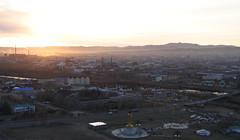
We took off from Ulaan Bator at around midnight and touched down in Seoul at around four in the morning local time. There we dragged ourselves through customs — just a tip, if you buy duty-free alcohol in Chinggis Khaan International Airport, remember your receipt if you don't want to run afoul of liquid carry-on rules when you transfer in Korea — and collapsed onto the waiting couches. I stayed up while the others napped, and watched the airport wake up around us; I had just enough energy for a last-minute run to the Dunkin' Donuts on the far side of the terminal for some jelly-filled fuel before it was time to board again at around 7:30. From there it was a short flight back to Fukuoka and the breaking of the fellowship; my Fearless Leader duties discharged with everyone back safe and sound, I caught the train back to Karatsu and began the task of catching up on about two week's worth of sleep.
Ok, so, now it's retrospective time. While two years living in Japan may have reduced the number of Habitat trips I organize on a yearly basis considerably from its peak in college, I think I can say that my Fearless Leading skills have not been totally dulled from disuse. While I know there were instances where I could've handled things better, for the most part I think I was able to stay calm, flexible, and on top of most problems that cropped up, both beforehand and during the trip. I can say that I don't think I would've been able to pull together all the disparate components of the trip and kept things organized and on a relatively smooth course had I not had the experience of leading similar (if not always as complex) excursions back in the states. While my team members said some kind things about my leadership afterwards, the truth is it was the Mongolia HFH and Darkhan affiliates who made our time as rewarding as it was, and my role was largely that of a facilitator for those experiences, a role which I find myself happy to play. I have worked with a lot of Habitat affiliates — over two dozen at least — in my years of volunteering with the organization and Mongolia HFH was definitely one of the best I've ever built with, in terms of providing real, rewarding work for its Global Village team participants. I would highly recommend it, and Mongolia, to anyone as a destination worth exploring.
I recently read this post on the slacktivist blog about the rationales behind mission trips and other service programs; although our team was independent of any church affiliation and the group a largely areligious one, I still think this example (speaking of a hypothetical trip to build a schoolhouse in Haiti) would apply to our excursion as well. Speaking to the question of, "couldn't we use the money on service programs some better way", he writes:
But the point of these mission trips is not only to get the school built. That's part of it, but it's not the only goal. The mission trip is also designed to give the American youth group a tangible, visceral stake in the fate of the Haitian community. This is vital for the people in Haiti too. ... It's unlikely that the youth group, the church, or any other given community here would raise the same amount of money without the personal stake of the trip itself.
The purpose of the mission trip is not exclusively to change the Haitian community where the school is to be built. Part of the purpose of the trip is also to change the young Americans who are going there, and to change the community that sends them. Part of the reason for such trips is to nurture a sense of empathy, of solidarity, and an ethos of service -- to create and maintain the capacity to care whether or not children in Haiti have a decent place to go to school, and to create and maintain the desire to help.
It's a big world, and there are no shortage of problems in it. Mongolia is a big country, with its own share of problems as well. I hope that our team's contributions — over 600,000 yen worth, once I get the last of the donations sent along — can be used as a seed for future investment in affordable housing in Darkhan, and I know that there are two families there who now have strong, decent housing in part thanks to our efforts. I have to think that counts for something, but I also know it's not enough to stop there. If my work as team leader, and the far more critical work of the local Habitat employees, guys like Baynaa and Batbold, has helped spread the message that the people of Mongolia are worth caring about, then I think I can consider this trip an accomplishment.
Hopefully there will be more to come.



No comments:
Post a Comment